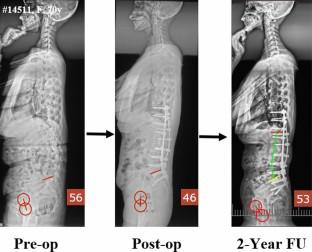European Spine Journal ( IF 2.6 ) Pub Date : 2022-09-30 , DOI: 10.1007/s00586-022-07391-9 Zongshan Hu 1 , Chang-Chun Tseng 1 , Jie Li 1 , Zhikai Qian 2 , Ziyang Tang 2 , Chen Ling 2 , Yanjie Xu 1 , Zhen Liu 1 , Zezhang Zhu 1 , Yong Qiu 1

|
Introduction
Pelvic incidence (PI) is a key morphological parameter that reflects the relation between the sacrum and iliac wings. It is well accepted that PI remains constant after reaching maturity. However, recent studies indicated that PI might be altered after lumbosacral fusion. Additionally, it remains uncertain on the long-term influence of long fusion to pelvis with S2-alar-iliac screw on PI in patients with adult spinal deformity (ASD).
Study Design
A retrospective study.
Objective
To investigate whether and how PI would change during the follow-up in ASD patients who underwent S2AI fixation and to identify factors associated with the change in PI.
Methods
We retrospectively reviewed all ASD patients who underwent spinal surgery using S2AI screws between November 2014 and January 2017 at our institution. Patients with minimum follow-up of two years were included. The following sagittal radiographic parameters were measured: PI, Lumbar lordosis (LL), pelvic tilt (PT), PI-LL, sagittal vertical axis (SVA) at pre-op, post-op and 2-year follow-up. According to the changes in PI at immediate post-operation, patients were classified into two groups; Group A: Changes of PI less than or equal 5° and Group B: Changes of PI greater than 5°.
Results
A total of 82 ASD patients (Group A: 32, Group B: 50; mean age of 53.5 ± 12.6 years) with a mean follow-up period of 30.2 ± 9.2 months were included in this study. At immediate post-operation, Group A showed no significant change in PI (45.7° ± 11.4° to 45.3° ± 11.2°, p = 0.749); while Group B had a significant decrease in PI (51.6° ± 14.5° to 40.9° ± 14.0°, p < 0.001). At the last follow-up, 48% patients (24/50) in Group B had a significant increase in PI (32.8° ± 6.4° to 45.8° ± 11.2°, p < 0.001). Intergroup analysis showed that ΔPI, post-op PI, post-op PT and age were significantly different between both groups. In addition, pre-op PI, post-op PI, post-op PT, post-op PI-LL were significantly correlated with ΔPI at last follow-up. Also, logistic regression analysis showed that post-op PI was the associated risk factor (OR = 0.865, p = 0.024) for PI-LL mismatch.
Conclusion
Our study showed that PI decreased in more than half of ASD patients immediately after spinal surgery using S2AI screws. Approximately 48% of them were able to recover during the 2-year follow-up. Lower pre-op PI, post-op PI and PT were found to be strongly associated with the return of PI. Thus, these current findings indicated that patients with a high PI at pre-operation should not be over-corrected to avoid PI-LL mismatch postoperatively.
中文翻译:

S2-翼-髂螺钉长骨盆融合术后骨盆发生率的动态变化:2年随访研究
介绍
骨盆入射率 (PI) 是反映骶骨和髂翼之间关系的关键形态学参数。人们普遍认为,PI 在成熟后保持不变。然而,最近的研究表明 PI 可能在腰骶融合术后发生改变。此外,成人脊柱畸形 (ASD) 患者使用 S2-翼-髂骨螺钉对骨盆进行长距离融合对 PI 的长期影响仍不确定。
学习规划
一项回顾性研究。
客观的
调查在接受 S2AI 固定的 ASD 患者的随访期间 PI 是否会发生变化以及如何发生变化,并确定与 PI 变化相关的因素。
方法
我们回顾了 2014 年 11 月至 2017 年 1 月期间在我们机构使用 S2AI 螺钉接受脊柱手术的所有 ASD 患者。包括最少随访两年的患者。测量了以下矢状位放射学参数:PI、腰椎前凸 (LL)、骨盆倾斜度 (PT)、PI-LL、术前、术后和 2 年随访时的矢状位垂直轴 (SVA)。根据术后即刻PI的变化,将患者分为两组;A 组:PI 变化小于或等于 5°,B 组:PI 变化大于 5°。
结果
本研究共纳入 82 名 ASD 患者(A 组:32 名,B 组:50 名;平均年龄为 53.5 ± 12.6 岁),平均随访时间为 30.2 ± 9.2 个月。术后即刻,A 组 PI 无显着变化(45.7° ± 11.4° 至 45.3° ± 11.2°,p = 0.749);而 B 组的 PI 显着下降(51.6° ± 14.5° 至 40.9° ± 14.0°,p < 0.001)。在最后一次随访时,B 组 48% 的患者 (24/50) 的 PI 显着增加 (32.8° ± 6.4° 至 45.8° ± 11.2°,p < 0.001)。组间分析显示两组间的 ΔPI、术后 PI、术后 PT 和年龄均有显着差异。此外,术前PI、术后PI、术后PT、术后PI-LL与末次随访时的ΔPI显着相关。此外,逻辑回归分析表明,术后 PI 是 PI-LL 不匹配的相关风险因素 (OR = 0.865,p = 0.024)。
结论
我们的研究表明,在使用 S2AI 螺钉进行脊柱手术后,一半以上的 ASD 患者的 PI 立即下降。在 2 年的随访期间,大约 48% 的患者能够康复。较低的术前 PI、术后 PI 和 PT 被发现与 PI 的恢复密切相关。因此,这些目前的研究结果表明,术前高 PI 的患者不应过度矫正以避免术后 PI-LL 不匹配。











































 京公网安备 11010802027423号
京公网安备 11010802027423号